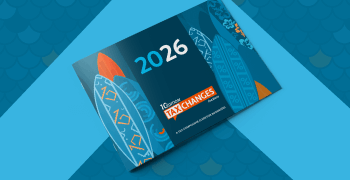
How to implement property tax compliance automation
For a long time, businesses had limited options for managing property tax compliance. They could handle it manually — calling on in-house tax and finance managers up to their furrowed brows in spreadsheets or relying outdated technology solutions — or outsource to accounting or specialized consulting firms.
Then came advanced property tax compliance automation, offering an alternative that can save businesses time and money. An advanced automated property tax compliance solution improves accuracy, helps ensure your business meets deadlines, and frees your team to focus on high-value activities like analysis.
However, a question most business leaders ask before making any change to their operations or back-office systems is, What are the impacts of adopting a new technology?, or more importantly, adopting a new method for achieving compliance? Even if you know a property tax compliance system is a brilliant idea for your company, you might fear how much effort may be required to get up and running.
Implementation can be a deciding factor when evaluating property tax compliance software. Many criteria must be considered to ensure your chosen solution will continue to meet your needs as your company changes and grows.
Before we discuss the questions you should ask about implementing an advanced property tax solution, let’s define what we mean by a property tax compliance solution and highlight how it differs from the more common methods used today.
An advanced property tax compliance solution is cloud-based software as a service (SaaS) that minimizes data entry, organizes and processes documents, and provides streamlined workflows less susceptible to human error. It automates many tasks that can make manual property tax compliance feel overwhelming, like tracking asset valuations for real and personal property, crunching numbers to fill out returns, keeping tabs on assessments, tracking various deadlines across multiple jurisdictions, and the list goes on and on.
Now, let’s explore some critical questions when deciding on a system.
How will an advanced property tax compliance solution complement my existing financial systems?
Your existing tech stack will benefit if you choose a property tax compliance solution that integrates with the accounting or ERP system you already use. Without an integration that’s prebuilt, your systems administrators might have to build a custom integration, which would take significant time and resources.
Your financial systems and an advanced property tax compliance solution can share data automatically. This can occur in several ways. One method is to export a CSV or Excel file from your property tax compliance solution. Another is to automatically import data from or to your accounting or ERP system. You can schedule this data transfer at an applicable or convenient time, such as the end of each day or the end of the year.
Another way to integrate systems is to use an API. An API allows you to sync data between software programs in real time instead of at scheduled intervals. This helps ensure updates are always reflected in both systems and minimizes work for finance teams. Property tax payables transfer seamlessly between your financial system and your property tax compliance system, keeping you on top of tax invoices that come with hefty penalties for being delinquent.
How much work is needed to integrate a property tax compliance automation solution?
One of the biggest benefits of a cloud-based property tax compliance solution is that once it’s set up, you typically just need a web browser. How much work you must do upfront depends partly on how you integrate your solution with your financial systems.
If you want to build an API integration, it helps to have technical expertise. Your vendor can offer guidance, but to protect your sensitive and personal data, they have limits. It also helps if the automated property tax compliance solution vendor you’re considering offers prebuilt integrations and developer tools for custom API integrations.
If you don’t have the IT staff to build an API integration, automatic CSV or Excel file transfers can be a good option for your business. Integrating your property tax compliance solution with your financial systems using this method means less work for your team.
Whichever path you choose, a tax or finance manager at your company will have to gather the information that will be put into your new property tax compliance solution at implementation. For example, you’ll need the addresses of your real estate locations, a list of your tangible personal property assets, and details about accounts you have with assessors and collectors.
You can save a lot of time by selecting a solution that allows you to scan blank returns, assessment notices, and tax bills uploaded into the system. This can spare you from manually keying in details like account numbers, addresses, and due dates. Or choose a vendor that will enter this information for you.
When evaluating your solution, ask if implementation specialists can explain exactly what information is necessary during setup and how your data must be structured. Spending time during implementation to feed your solution with correct information helps you be better organized. Expect to get more time back than you put in.
Does my business need IT staff to administer and maintain a property tax compliance solution?
It’s typically smooth sailing after implementing your automated property tax compliance solution. When you choose Avalara Property Tax, you don’t have to have staff to maintain the software.
If you work at a big business, you may have a legacy on-premises property tax compliance system. These systems require regular updates and security patches; without them, they become obsolete.
Software as a service (SaaS) is automatically updated. The solution lives on the web so you can access it anytime, from any location with an internet connection. Want to provide a new team member with access to your account? It’s as simple as creating a username and password.
Some tasks can be easier to perform using a SaaS solution. Even if on-premises software provides the fundamental information you need to do your job, extracting that data for analysis might require more effort than you’d like.
How soon after buying a property tax compliance solution will my business benefit?
You may wonder how long it takes between purchase and when you can use your property tax compliance solution. When you choose Avalara Property Tax, your business can experience benefits in approximately six to nine weeks. Avalara provides hands-on training. The implementation schedule is roughly the same for small, midsize, or enterprise businesses.
From then on, you can quickly access all your data, view a calendar that shows you what’s coming up, and run reports to make decisions. For example, you can provide your financial team or executives with status reports of property assessments in appeal and help quantify how much you could save.
Those savings can add up quickly. A 2022 survey by Potentiate and Avalara found that many companies pay property tax penalties or overpay yearly. Among those surveyed:
- 61% of respondents are penalized from 5% to 15% on real property tax bills
- 62% of respondents are penalized from 5% to 20% on personal property tax bills
Only 37% of the businesses surveyed by Potentiate use property tax software.
You’ll also save time. Potentiate also found in a separate study that businesses invest weeks navigating the complexities of property tax compliance. Automating this process empowers tax and finance professionals to redirect their efforts toward activities that enhance profitability.
How are other companies handling property tax compliance?
You might be surprised to discover that managing property tax compliance manually is ubiquitous, even among enterprise organizations. Compliance was a real challenge for a company like Comcast, where property assets spread widely across jurisdictional boundaries. “We’ve got cables and all sorts of other electronic infrastructure that doesn’t recognize jurisdictional boundaries,” says Allyssa DeCenzo, a property tax manager at Comcast. “We were doing all allocations manually and then printing and mailing the returns for each jurisdiction.”
Property tax returns were due every two weeks of the first six months of each year. The manual effort to process and file thousands of them was a severe drain on the team. Adding to the concern, the entire process was largely undocumented — it lived in the brain of a single compliance manager — creating another layer of risk.
Implementing an automated tax solution provided them a secure hub for real property and business personal property tax information and tax-related activities. It automated data entry for critical assessment notices, tax bill document management, deadline management, asset categorization, and depreciation schedules.
It also provided them with a single system for generating return forms, assessment notices, appeals, and tax bills, significantly streamlining Comcast’s compliance processes.
By implementing Avalara Property Tax, Comcast manages returns with half the resources previously dedicated to the task. The company’s property tax compliance team has more time to be proactive with assessments and valuations, so they file fewer appeals after the fact. Property tax compliance automation also streamlines Comcast’s audit process.
Take the next step and learn more about Avalara Property Tax
Contact one of our property tax compliance automation specialists to learn how to implement Avalara Property Tax for your business. They’ll answer your questions, walk you through steps to get started, and give tips on getting the most out of property tax software.

Avalara Tax Changes 2026 is here
The 10th edition of our annual report engagingly breaks down key policies related to sales tax, tariffs, and VAT.
Stay up to date
Sign up for our free newsletter and stay up to date with the latest tax news.














